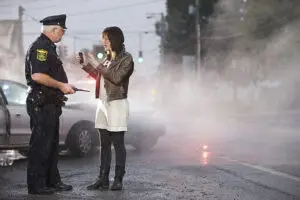Where Is the Safest Place to Pull Over After an Accident?
Motor vehicle accidents are among the most stressful situations a person may face. While many people have seen footage of an accident, most are not prepared to be involved in one of the millions of crashes occurring each year in the United States. When unprepared, a person is likely to panic and increase their risk of injury to themselves or others.
 Fortunately, the skilled car accident lawyers at Munley Law have decades of experience fighting for fair compensation for accident victims. Our law firm’s experience leaves us well-equipped to tell you the proper action to take following an accident, such as where to pull over and other immediate steps.
Fortunately, the skilled car accident lawyers at Munley Law have decades of experience fighting for fair compensation for accident victims. Our law firm’s experience leaves us well-equipped to tell you the proper action to take following an accident, such as where to pull over and other immediate steps.
Where to Pull Over After an Accident
If you are involved in an accident on a freeway, the shoulder is the most readily available place to pull over. It is often the only somewhat safe option to turn after an accident.
Which Side of the Highway Is Safe to Pull Over On?
If it is safe, pull over onto the right shoulder, not the left. Attempting to pull over onto the left shoulder of a divided highway would force you to cross over a lane. This would be very dangerous, as it could make you crash into the barrier or put you directly in the path of other motorists. The only situation in which you should consider pulling over to the left is when your car breaks down, and you have no choice.
City streets
If you are on a city street instead of the highway, you might be able to pull over into a parking lot to avoid traffic. If not, try to pull over at some well-lit, safe, and uncrowded area.
Make Your Car Visible and Warn Other Drivers

Before you pull over, you must clarify your intentions to those you share the road with. If your car is still on the road, most drivers will not expect you to turn onto the shoulder or through lanes suddenly. They need to be warned appropriately so that your accident does not become dangerous for them as well.
You must make yourself visible wherever you pull over to avoid being struck by other drivers when not moving. Do this by turning on your hazard lights or emergency flashers. This will alert drivers to your presence and decrease the risk of an additional accident while you are on the side of the road. In addition to flashers, you may also use signals such as reflective triangles, road flares, or traffic cones if available to you and if you can set them up safely.
Where Not to Pull Over
There are several places where it is especially important not to pull over. Some are blind curves where other drivers may not be able to see you, very narrow shoulders with limited space, tight bridges or tunnels, designated emergency vehicle lanes, construction zones, intersections, or hills.
You must avoid blocking traffic lanes or obstructing the flow of traffic, as doing so puts you and any oncoming drivers in even more danger.
Immediate Steps to Take Following Car Accident
The first step after a car accident is not to leave the scene. Regardless of whether you think you are at fault, you are legally required to stay at the accident scene if you can safely do so. If you do leave, the situation becomes a hit-and-run accident, and you could face criminal charges. Once you have situated yourself, there are other steps to follow.
Move Yourself and Your Vehicle to a Safe Spot
Get to a safe place, like a highway shoulder. If it is safe to do so, get out of your car. If not, and there are no signs of gas, smoke, or fire, you should stay in the car.
It is essential to stay vigilant even if you make it to a shoulder. According to AAA, pedestrian fatalities on a highway (including highway shoulder pedestrian crashes) make up around 10% of all pedestrian fatalities in the United States. Be alert and make yourself visible so you do not become a victim of a highway shoulder pedestrian crash.
Call the Police and Get Medical Help
 If you are able, you should check everyone for visible injuries. That includes yourself, any of your passengers, and even the people in the other car. Regardless of whether any accident symptoms are immediately apparent, you should contact emergency services and law enforcement as soon as possible.
If you are able, you should check everyone for visible injuries. That includes yourself, any of your passengers, and even the people in the other car. Regardless of whether any accident symptoms are immediately apparent, you should contact emergency services and law enforcement as soon as possible.
Calling 911 allows medical assistance to arrive quickly at the scene. Some injuries are serious and require an ambulance, while others need to be identified by medical professionals. Whatever medical attention is needed can only arrive if you seek help.
In Pennsylvania, you must file a police report after any accident that results in injury, death, or property damage exceeding $1000 with local or state police departments. This allows police officers to inspect the scene and create an accident report. The information in them is valuable not just to the police but to anyone seeking an insurance claim following an accident.
Document the Scene if You Can
It is essential to document any relevant accident details at a car crash scene so that you can paint a clear picture of how the crash occurred. This information may include date and time, location, weather conditions, road conditions, visible vehicle damage, vehicle information, license plate numbers, injuries, etc. Close-up photos of things such as nearby traffic signs or skid marks on the road may also be relevant. It is essential to document as close to the entire scene as possible. You may also be able to access the information contained in police accident reports.
Exchange information
You should not say too much to the other driver involved in an accident, as you may agitate them or accidentally admit to being at fault. However, it is important to exchange information, mainly insurance information. First, you should learn if they are an insurance carrier, who their insurance provider is, vehicle identification, personal information, phone numbers, or other contact information. This may begin the insurance claim process between your insurance companies and is a crucial first step if you plan to sue an at-fault driver for damages or make a personal injury claim.
Move Over Laws
Pennsylvania Move Over Law outlines what should be done when passing a disabled vehicle. A driver must legally switch into a lane “not adjacent to” the car if possible. If that is not possible, other rules apply. You must pass the vehicle at a slower speed, up to 20 miles per hour, which is slower than the speed limit. Failure to follow these guidelines is considered a summary offense in Pennsylvania, and those who do not comply may be subject to fines.
When a Car Is on the Shoulder, Move Over to the Next Lane
If you encounter an auto accident scene or a vehicle on the shoulder for any reason, remember to steer clear of it and move to a farther lane.
If You Have Been Injured in a Car Accident, Call Munley Law
Were you or a loved one injured in a car accident? At Munley Law, our experienced car accident lawyers will fight against insurance companies to get you the compensation you deserve. From serious injuries to wrongful death cases, we handle your claim with compassion while you focus on recovery. Don’t let medical bills and lost wages overwhelm you – contact us today to discuss your case with a skilled personal injury attorney.
Posted in Car Accidents.









